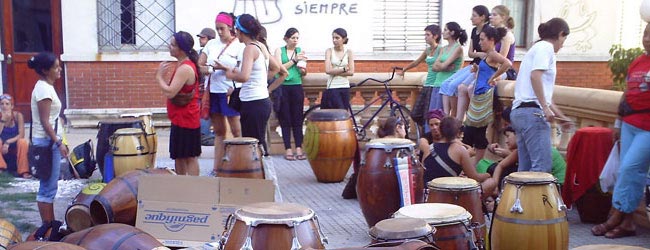Join the UruguayNow mailing list:
UruguayNow in the press
UruguayNow's mix of travel and tourist information on Uruguay, hotel reviews for Montevideo and Punta del Este (coming soon for Colonia), restaurant reviews and tips on excursions, sightseeing and lifestyle in Uruguay has been featured in El Pais, La Republica, MercoPress and on Uruguay's Channel 5 TV and other news media in the country. Internationally, we have had kind mentions in the New York Times and the Daily Telegraph.
Best of the Web
Not yet made it to Uruguay? When you're done with UruguayNow, our choice of the top 6 internet resources for the country is just a mouse click away. In no particular order, they are:
Southern Cone Travel: http://southernconeguidebooks.blogspot.com/
Mercopress: http://en.mercopress.com/
Ola Uruguay: www.olauruguay.com
Retired in Uruguay: http://wallyinuruguay.blogspot.com/
Uruguay Natural: www.uruguaynatural.com
Global Property Guide: http://www.globalpropertyguide.com/Latin-America/Uruguay
For reviews of these sites, please click here.
Other recommended sites

Uruguay gets a female beat
The drummers of La Melaza have broken into a man's world
When La Melaza, a group of female drummers, formed in 2005 it was out of a sense of wanting to do something together. Choosing candombe, a style of drumming usually performed by men, meant they were bound to raise a few eyebrows.
The idea for the group came as a way of celebrating International Women's Day. Candombe was an obvious choice. It is the nation's most distinctive beat, created by African slaves in Montevideo as a way of expressing themselves. They would use scraps of wood to create barrel-shaped drums, similar to ones made from tree trunks in their homelands. Candombe was the name of the rhythm they played and its popularity soared when European immigrants began to take an interest.
With candombe chosen, word was sent out for any women who might be interested. La Melaza ("treacle" in English) now has 78 drummers, including psychologists, teachers, carpenters and publicists, many of whom were completely new to drumming, never mind candombe. After a few practice sessions they took to the streets on International Women's Day, attracting a huge crowd of onlookers on Avenida 18 de Julio, the main artery in downtown Montevideo.
“What people found interesting was that we were women. At the time, it was only men who played candombe. For everyone to see all these women drummers who sounded tremendous – it was incredible!" says Laeticia Lonchar, one of the group's founders.
After such a positive response – and with so many drummers taking part – giving up was out of the question.
“As we started to learn from nothing, or close to nothing, we developed a very clean style with a total respect for the traditions of candombe. With time we found the right style for our physiques and levels of energy," says Ana "Chacha" de León.
Candombe drums are struck with either both hands or one hand and a stick, and performances can last up to two or three hours. The women knew that it was never going to be possible to match the unrelenting power of some of the men's groups. Instead, La Melaza alternate explosive sections with calmer periods allowing them to rest a little.
They are all keen scholars of candombe and stress its historical importance.“The difficult thing is to generate interest that is not just about having fun. Candombe has such a strong significance that you have to care for it a little too," says Fernanda Bártola.
This sense of building on the Afro-Uruguayan roots of candombe finds its expression in the home-made chains they wear round their ankles – but most especially in the music itself. In a piece called El afro, the dancers rise up from the ground as if to free themselves, before the drums explode in a frenetic rhythm that constantly changes before finally subsiding. Here, the women opt for a traditional African beat rather than the normal candombe rhythm. In the world of Uruguayan drumming, this is an unconventional departure.
Are the ladies of La Melaza a little self-conscious in a man's world? “Not at all," says Fernanda Bártola, "we care about what we are doing and anyway there are so many of us. It's a natural thing now. These are women who play candombe really well and no longer need to worry whether it sounds good. That's a feeling that we didn't have at the beginning."
The group is now a fixture in Montevideo's Parque Rodó every week (see below), as well as in the Carnival parades and the Llamada de Los Reyes, historically the most important date in the candombe calendar. Their participation in the 2008 Carnival was the first time an all-female group had been admitted. They finished eighth in the competition, a sign of their growing prowess. Since their debut at the International Women's Day celebration in Montevideo in 2005 more groups of female drummers have formed, spurred on by La Melaza's success. But women drummers are still in a minority.
Surprisingly, at the end of the nineteenth century there are records of female Uruguayan drummers. According to historian Oscar Padrón Favre, 14 out of 34 comparsas (groups of drummers and dancers) in 1870 were women-only. At the time, they generally appeared at family gatherings and masked balls. Newspaper reports from the inland city of Durazno in 1889 tell of a female group, the Negras Orientales, which would perform in white and sky-blue dress. So why did women in Uruguay stop drumming? The history books give us no convincing answers.
Factfile: You can find out more about La Melaza – including details of appearances around the country – via the group's website: www.lamelaza.com. You can see the group in the Parque Rodó neighbourhood every Sunday starting on calle Blanes street at around 7 pm (the route takes them to calle San Salvador). Just follow the sound of drums. On the last Sunday of each month La Melaza encourages male drummers to join them.
